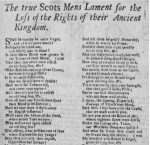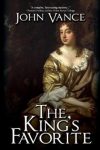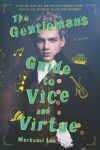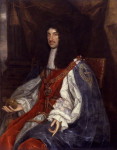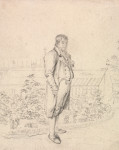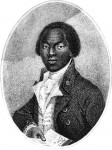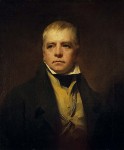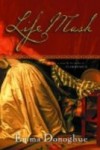The past two decades have seen an outpouring of historical novels that resembles the deluge that swept across Europe and North America in response to Sir Walter Scott’s best-selling Waverley series, 1814-1832. Like the followers and imitators of Scott, today’s historical novelists show a wide range of writerly ability; some of these novels are much better written, more compelling, and more original than others. They have also invented new approaches to the genre, such as the historical detective story, the novel-within-a-novel, and historical fantasy.
Yet we still turn to historical fiction because we want to experience the past in an immediate and enjoyable way. We want to know what the people were like, how it felt to live in London during the plague or Paris during the revolution, whether Marie Antoinette was an airhead or Charles II was a cad. Inevitably, we wonder: is what this novel saying true? What is this writer making up? Why should writers turn to the eighteenth century, as so many of them have?
This collection seeks to provide answers to some of your questions. Some of the writers on this page are scholars; some of them are novelists. Some of them are both. But we hope that our collected contributions add to your enjoyment of your books and the eighteenth century.
This Collection is curated by Martha Bowden. Click Join Us if you would like to contribute to this Collection.
July 31, 2019
Since January 2019, the Scottish Opera has been holding interactive performances of a Jacobite-themed production entitled 1719! in dozens of primary schools across Scotland. Examination of Jacobite ballads printed around 1719 in relation to 1719! reveals shared patterns of thought: both 1719! and Jacobite ballads instrumentalize the past to cultivate a unique Scottish identity and sense of a cyclical history that resonates with contemporary cultural and political aspirations.
November 9, 2018
A retired professor writes a work of historical fiction: a mystery thriller featuring fictional and factual characters, including Lady Castlemaine, Nell Gwynn, and Charles II.
June 4, 2018
Janet Lunn’s Hawthorn Bay trilogy for middle-grade readers, comprising The Hollow Tree (1997), Shadow in Hawthorn Bay (1988), and The Root Cellar (1981), follows the fortunes of a community initially torn apart by the American Revolutionary War, through the settlement of the Loyalists in southeastern Ontario, the arrival of Scottish immigrants, the American Civil War, into the present.
April 5, 2018
Scholars Joe Drury and Danielle Bobker discuss how a recent novel — The Gentleman’s Guide to Vice and Virtue by Mackenzi Lee — evokes an “engagingly louche” eighteenth century for young adult readers.
November 3, 2017
Writing this book was a great pleasure because it allowed me to investigate one of my favorite forms of fiction while employing my scholarly interest in the development of the novel. I realized that I have been reading historical fiction for most of my life. Writers of historical fiction today need not have read a Waverley Novel in order to be influenced by Walter Scott, any more than we need to know who our great-great-grandparents are for our genes to be affected by them. The first section of my book contains two chapters that develop this critical framework. In the second, I devote two chapters to the establishment of authenticity while retaining accessibility, the first on literary intertextuality and the second on the use of images, such as portraits, both historical and fictional. Readers of historical fiction are interested in the “truth” of the narrative, but they generally are concerned about the what and I am interested in the how, which is the function of romance. The third section covers the metamorphosis of the form, with the first chapter discussing three subgenres: the embedded narrative, the historical detective novel, and young adult fiction.
September 5, 2016
Humanities Viewpoints is a monthly podcast from the Wake Forest University Humanities Institute. It features short conversations between host Aimee Mepham, Humanities Institute Assistant Director, and a WFU faculty member working in the humanities. The September episode, the first of the 2016-2017 academic year, features a conversation between Mepham and Jake Ruddiman, Associate Professor of History at Wake Forest University, on Hamilton, the man and the musical. Ruddiman, a scholar of the American Revolution, received his PhD from Yale and joined the WFU faculty in 2010. His first book, Becoming Men of Some Consequence, presents the experiences of young men fighting in the Revolutionary War. His next projects explore the Revolution in the Southeast.
June 8, 2015
It was the sixties—albeit the 1660s—a time for tricksters, rakes, subversive women and sexual energy on the stage. It was a time of fun for those with the means to partake of it. The “good old days” are, of course, always better from a distance, but writers on through the twentieth century found the Restoration an apt setting for their fictions about prostitution, political intrigue, and tragic or comic historical events, especially for the cinema.
October 27, 2014
Now that Scots have voted to remain with the United Kingdom, perhaps it is more appropriate to recognize that the vote was also held during the bicentennial of Walter Scott’s Waverley—a novel that at once celebrates a distinctively Scottish identity and defends the established Union as a valuable political arrangement. This complex statement of Scotland’s union with England has echoes in the referendum itself.
February 24, 2014
Olaudah Equiano was most certainly a key figure in the abolition movement of the eighteenth century. His narrative, The Interesting Narrative of the Life of Olaudah Equiano, Or Gustavus Vassa, The African (1789), is one of the best known of the ere and […]
February 19, 2014
I don’t expect Walter Scott’s novels to be re-imagined to include kilt-wearing vampires any time soon. But I am confident that readers interested in the eighteenth century would be drawn to Scott’s representations and interpretations of what he recognized as a tumultuous and exuberant age.
July 28, 2013
The eighteenth century has served as the backdrop for some of the greatest historical novels, from William Makepeace Thackeray’s The Luck of Barry Lyndon (1844) to Hilary Mantel’s A Place of Greater Safety (1992) and Thomas Pynchon’s Mason and Dixon (1997). But the century also produced a large number of historical novels, many of which are less well known. My book British Historical Fiction before Scott (2010) examines the popular historical novels of this era. I look at 85 novels published between 1762 and 1813 to explore how the conventions of the historical novel took shape during this period, how the genre grew out of but eventually branched off from the Gothic tradition, and how it was received by readers and reviewers.
May 22, 2013
Kathleen Winsor’s historical romance Forever Amber (1944) and Laura Linker’s Dangerous Women, Libertine Epicures, and the Rise of Sensibility, 1670-1730 (Ashgate 2011).
May 17, 2013
Emma Donoghue’s historical novel Life Mask (2004) represents the lives of the 18th-century sculptor Anne Damer, actress Eliza Farren, and painter Thomas Lawrence. In a novel filled with artists and their subjects, a famous portrait plays a critical part in illuminating friendship and its rupture. Donoghue enhances the historical background of the creation and presentation of Lawrence’s portrait of Farren to reveal the conflicts that class and sexuality cause.
